
The Bottom Line
Introduction, Specifications, and Pricing
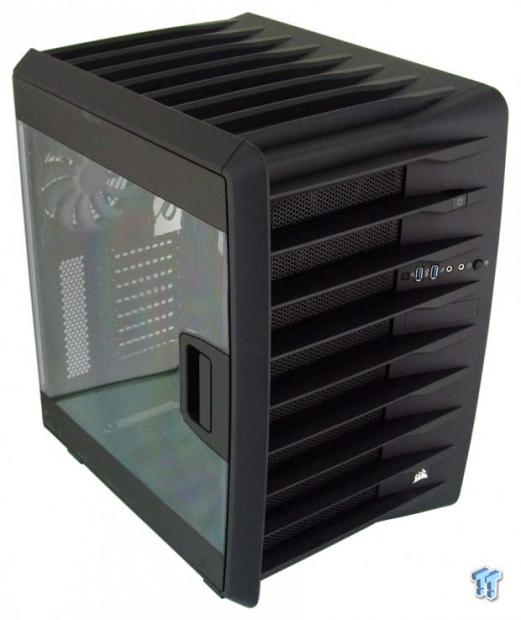
If we were to single out Corsair for one major thing they are known for when it comes to designing cases, it has to be their original styling that they reveal on many sexy cases. The 800D and 900D are beasts, but have a unique style that sets them apart, there are many of the usual suspects, but there are the Graphite series cases, which show that square does not have to be your only choice for exterior shape. Their Carbide series has always been delivered with a straightforward attack on their designs, by this we mean, that while they have individual styling cues, at the same time, the shapes are quite boxy. Even when it came to the Carbide Air cases from the past, the same idea of square cases was offered, yet a lot of concessions were made to optimize airflow, and as such, it gave these cases their own identity as well.
It just so happens that it seems that the Carbide Air 240 and the Carbide Air 540 were just not enough for Corsair, or maybe it was that after production of the Air 540, they thought they could have done things better. Either way, you want to look at it, it has resulted in the third version of the Carbide Air series cases. While Corsair stuck with everything which made the previous two successful, new ideas have been implemented, and the styling has changed so much that this new iteration no longer resembles its past. A whole new look is in store for the masses, and the layout inside is similar, yet Corsair can expand upon what we have seen before, upgrading the majority of the design.
We are speaking of the Corsair Carbide Air 740 High Airflow cube PC chassis, the latest and greatest of the Carbide Air cases. Internally, it is hard to shake the feel of the original designs, as dual chambered cases do tend to look alike at first glance. However, they have redesigned the 2.5" drive rack system, making it more modular than ever, they tend to wiring like never before, and even being a mid-tower chassis, it affords room for E-ATX motherboards. Externally, the vertical lines of the previous cases have been tossed out, and a whole new sheet of paper was used when delivering what we feel is an astonishing looking aesthetic to their latest creation. For those of you who missed out on the originals, or happen to have one and are thinking of an upgrade, now is the time, as the Carbide Air 740 from Corsair is on the hunt to be a market killer for many other companies.
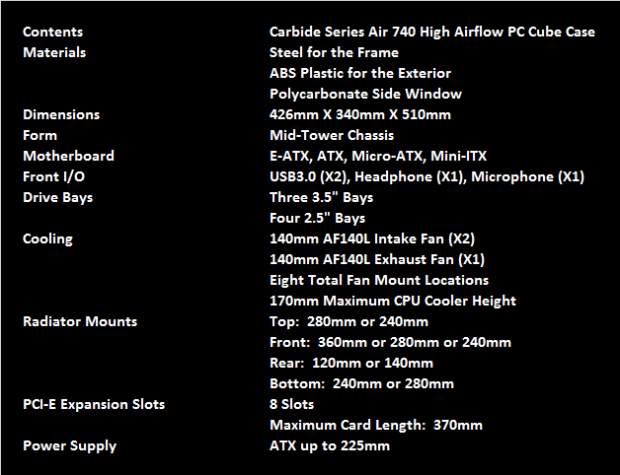
We had to devise the chart seen above, partly from the information found on the box, and checking that against the reviewer's guide. Inside of the box, you will receive the Carbide Series Air 740 High Airflow PC cube chassis, but you will have the option of white or black for the exterior. The chassis is made mostly of steel but also uses ABS plastic for components which attach to the top, the front, as well as the bottom. As for the left side panel, it resembles those from the Graphite Series and is made of polycarbonate. The dimensional figures show us that this chassis is 426mm from front to back, it stands 510mm in height, it is 340mm in width, and the shipping weight with packaging is 24 pounds. While this is technically a mid-tower chassis, you have options of using a Mini-ITX, Micro-ATX, ATX, and even has plenty of room for an E-ATX motherboard too.
The front I/O panel contains two USB 3.0 ports, a reset button, power button, a pair of HD Audio 3.5mm jacks, and an LED lighting switch. The bays are not found in the main compartment, as they have been moved to the right half of the chassis, not only for the looks but to keep wiring short and hidden from view. It is there in which we find a cage near the front housing three 3.5" drives. Near the back of the chassis, still, on the right side, we find another rack supporting 2.5" drives. This rack is a bit different as well, the individual 2.5" drive bays can come unclipped from one another, so you keep just what you need in the chassis. Back to the left side of the chassis, at the back, there are eight expansion slots for multiple card layouts, and each card can be up to 370mm in length.
Cooling by default is handled by a trio of AF140L fans. Two of them are placed in the front of the chassis, blowing in at the left chamber. The third fan is in the left chamber as well but is hanging in the back, used to exhaust the chassis. The Air 740 is designed to allow for eight fans. There is room for two 140mm or 120mm fans in the top, and the same setup is found in the bottom. The front of the chassis can house a trio of 120mm fans or two 140mm fans, and there is the fan at the back of the case left in this equation, giving us the eight fan locations. As for the water cooling support, the top and bottom are listed to house a 240mm or 280mm radiator, and the front is said to house a 360mm, 280, or 240mm radiator without issue. You can also use the back for water cooling support, but you are restricted to single radiators. We also found there is reservoir support in the back, but on the right side of the chassis, just above the PSU mounting location.
Since we are writing this review ahead of the launch of the Carbide Air 740, we did not see any listed online for sale. Corsair has briefed us on the pricing, and for a standard mid-tower chassis, the pricing is on the high side of the scale, but this is not a standard mid-tower chassis. Corsair has set the MSRP at $149 for this chassis, and after we show you what this chassis has in store for you, we think pricing will become a moot point in any argument. The Corsair Carbide Air 740 High Airflow PC cube chassis is just so stunning to see, and with everything laid out as it is, it is near impossible to not appreciate what this culmination of ingenuity, design, and aesthetic appeal delivers.
Chad's Chassis Test System Specifications
- Motherboard: GIGABYTE GA-Z68X-UD4-B3
- CPU: Intel Core i7 2600K (buy from Amazon)
- Cooler: Corsair H80i GT (buy from Amazon)
- Memory: G.Skill Ripjaws F3-12800CL6D-4GBXH
- Video Card: ZOTAC GeForce GTX 970 AMP. Extreme Edition (buy from Amazon)
- Storage: SuperSpeed 128GB SSD
- Power Supply: SilverStone SST-ST85F-G (buy from Amazon)
- OS: Microsoft Windows 7 Ultimate 64-bit (buy from Amazon)
Packaging
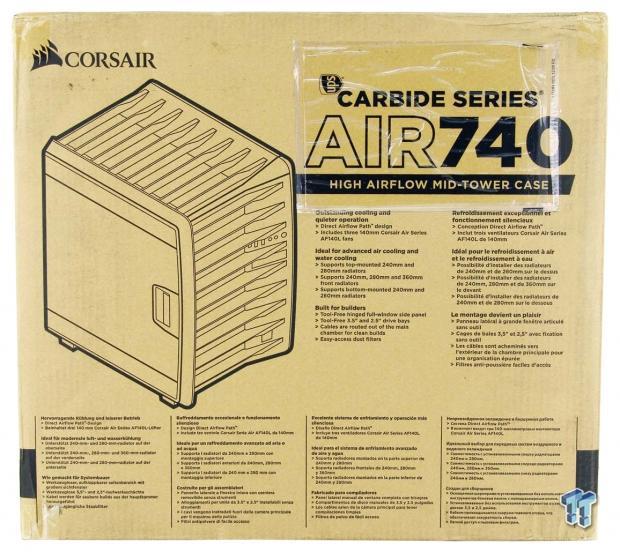
Opting to place the Air 740 in a plain cardboard box with black printing on it, Corsair can put your money into the chassis and not the packaging. A rendering of the chassis is found under the Corsair name, and to the right, we find features listed under the product name, which is repeated along the bottom in many languages.
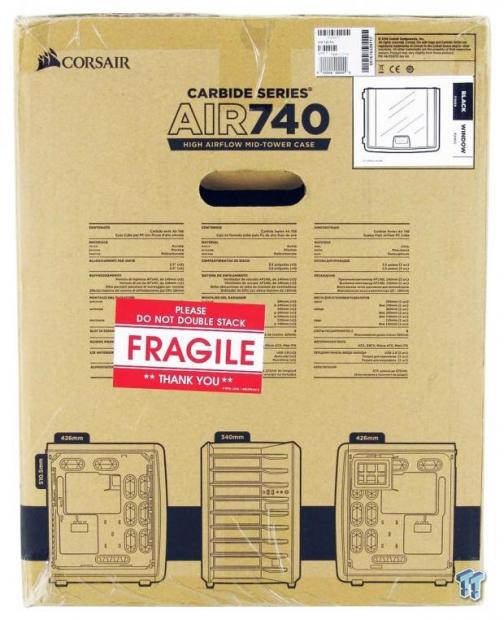
Next to the company and product naming, we find a sticker denoting two things. First of all, we can see that the chassis color inside of the box is black, and it also denoted that there is a window on the left side of this chassis. The midsection of the panel offers specifications charts, while the bottom is used to present three different views of the Air 740.
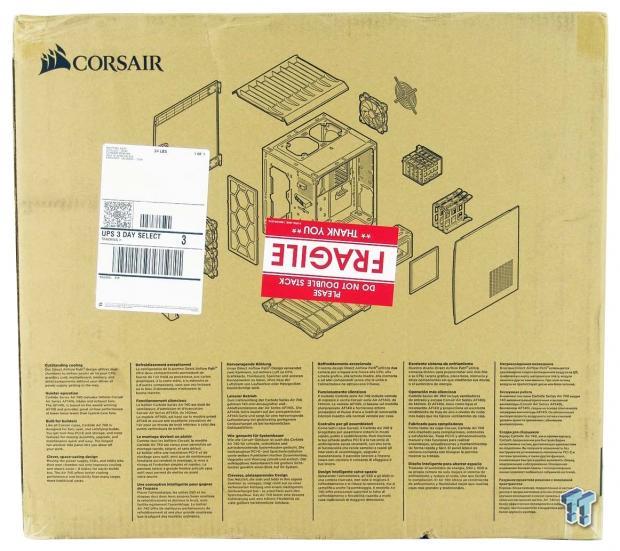
The large rendering, slightly covered with a pair of shipping stickers, is an exploded view of the chassis. This explains where everything is, and what components of the chassis can be removed. The bottom is used to talk about the Outstanding Cooling, the Quieter Operation, the Built for Builders mentality of the design, as well as the Clever Space-saving Design.
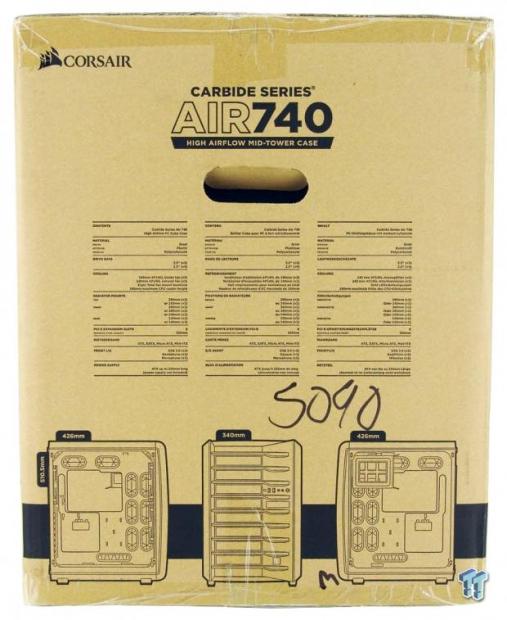
This side of the packaging mimics what we saw on the other side, most notably, the English specifications chart can be found on this side. As for the renderings along the bottom, they two are the same and show the dimensions as well.
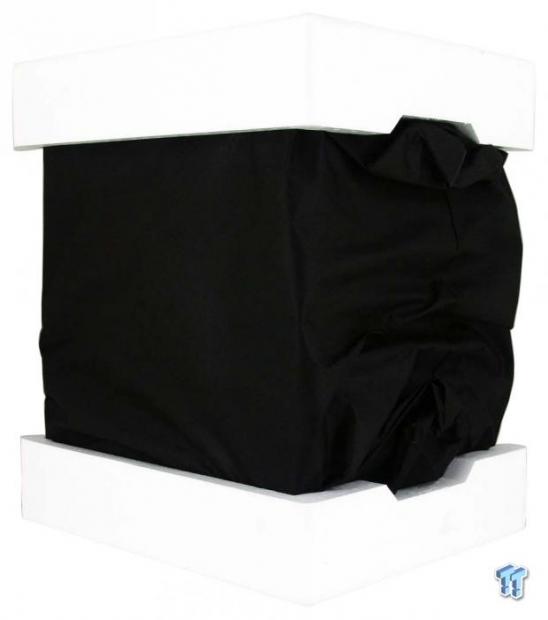
On both sides of the polycarbonate side panel, Corsair has placed plastic to cling to the window, ensuring nothing happens to that during transit. A few bits of tape on a magnetic dust filter and along the right front edge helps to keep parts in place, and the entire chassis is wrapped in a black cloth bag. The last step to protect the chassis is the use of thick Styrofoam end caps, to take on the bigger bumps and drops heavy cases get in transit.
While the box and packaging look outstanding, we did notice a little bit of damage to this early release sample and surmised it to have happened before the chassis was even packaged. Such things can happen in the rush to meet a deadline; Corsair tends to have good quality control with their cases on the retail end, so we are not too worried about it.
Corsair Carbide Air 740 Mid-Tower Chassis
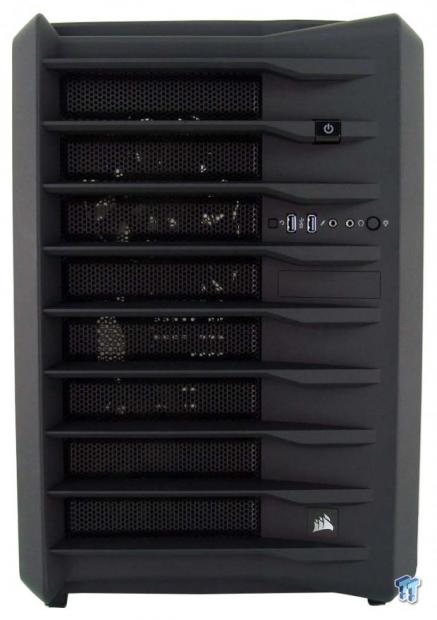
Instantly, due to the wide stature of the front bezel, we realize this is nearly two cases glued together. We love the horizontal bars across the face of the mesh and are also digging the odd angles here and there. The finish is matte, and cleverly houses the front I/O components on the right side.
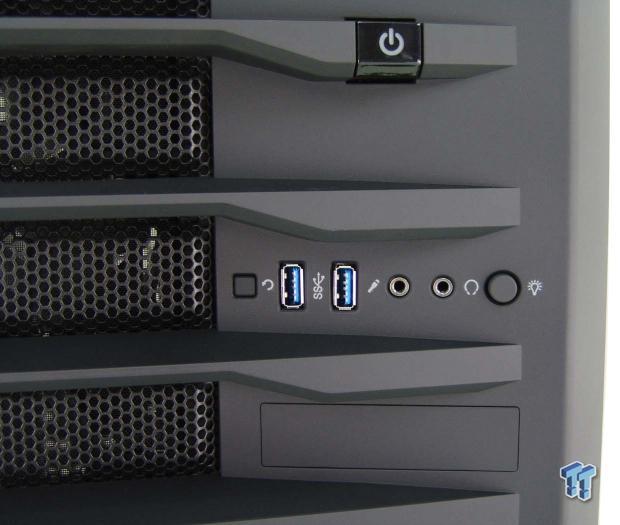
On the edge of one of the horizontal trim lines, we find the power button. Between a couple of the bars, just a bit lower, we see the rest button, USB 2.0 ports, HD Audio Jacks, and the LED light switch. We also notice there is a cover panel installed, but at this time have no idea what might go there.
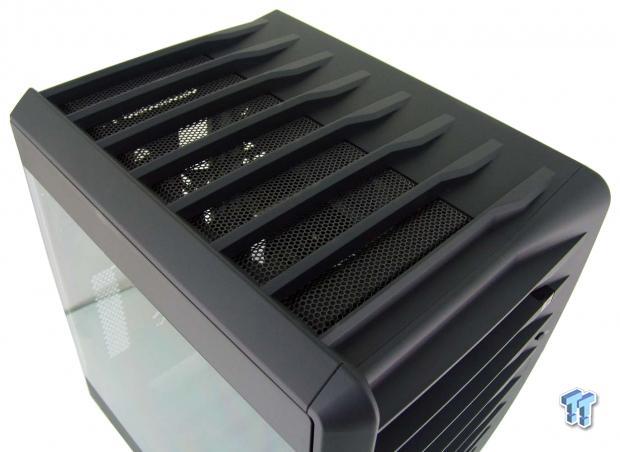
The same styling has been taken to the top of the chassis, where we find the same bar system used to cover the mesh. Both the front and this top panel are removable, which makes fan mounting a breeze.
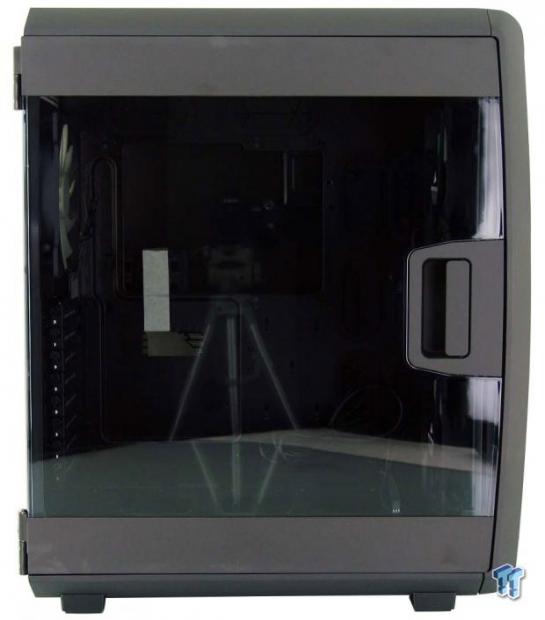
The left side of the chassis is shipped with this large clear side panel which opens from the front and is supported by hinges. The top and bottom bars of black are also part of the door and simplifies the thin gap around the panel as it meets the front bezel and top panel.
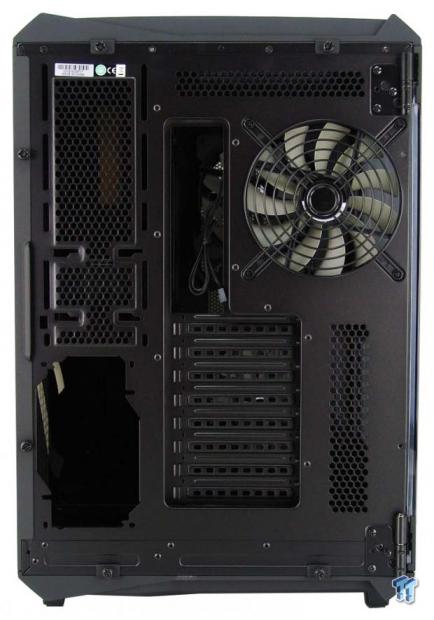
The left side of the back panel offers a few slots and holes around the mesh area, and can be used to mount a reservoir. Below that, we find the location for the PSU. The right section starts with some mesh at the top and just below are the rear I/O area and the exhaust fan. This leaves the eight expansion slots and the section of mesh to be at the bottom on this side.
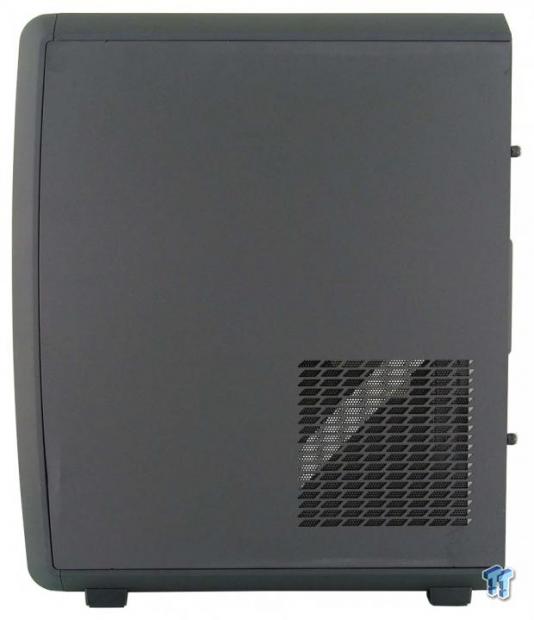
The right side of the case uses a panel which clips along the front, just behind the front bezel plastic. The panel is flat, and only gets broken up by the mesh area at the bottom. This allows for a fresh intake of air for the PSU, and we can see a bit of tape holding a magnetic dust filter in place. The front edge, near the bottom of the panel, is where we found damage, and you can just make out the fold line of the metal side.
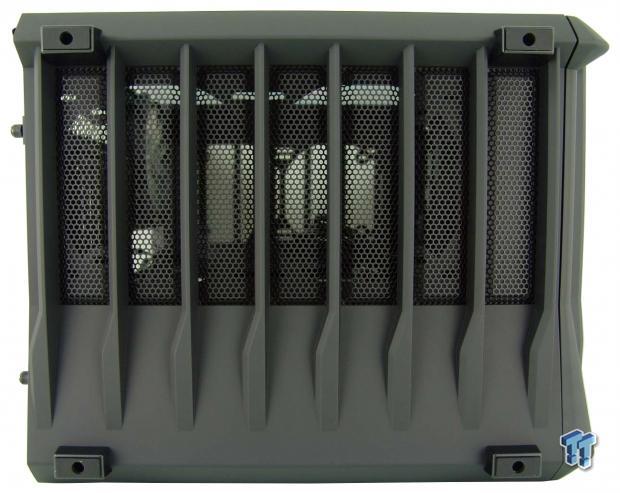
Even the bottom of the chassis gets more of the thick bars that run side to side. The floor of the chassis is open and does allow for fan mounting, and as such, the entire plastic cover is removable to clear the way for screws in the fans. The feet seem small of r the size of the chassis, but the rubber pads kept our Air 740 solidly in place.
Inside the Carbide Air 740
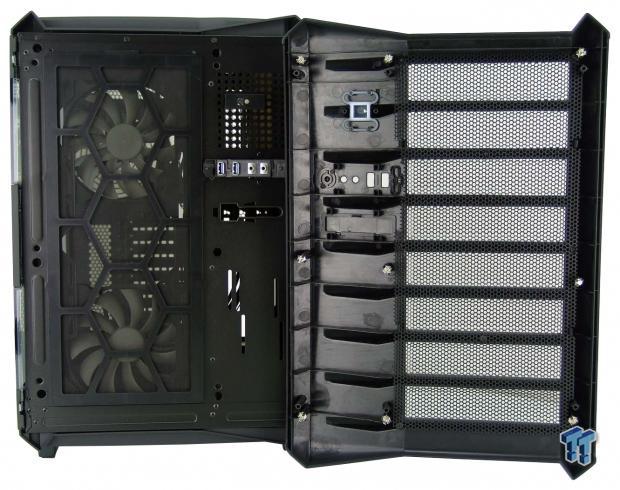
The front of the Air 740 can be removed. It uses nine clips to hold it tightly to the chassis. The switches and wiring are attached to the chassis and not the bezel, and we also find a large magnetic dust filter stuck to the front of the frame.
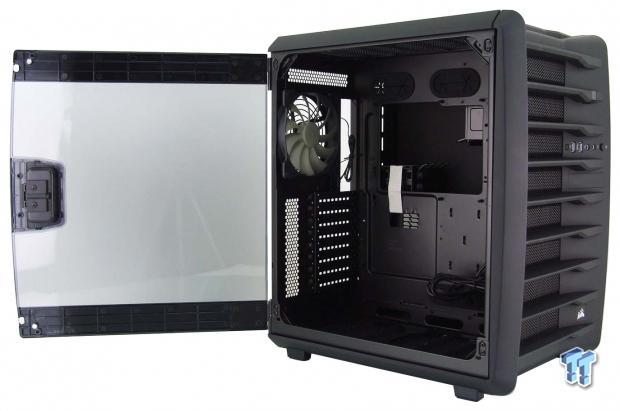
When building in the chassis, we do recommend removing the side panel by lifting it up off of its hinges. For day to day usage, though, the door swings open past 180 degrees and delivers ample access to the interior for parts swapping of maintenance.
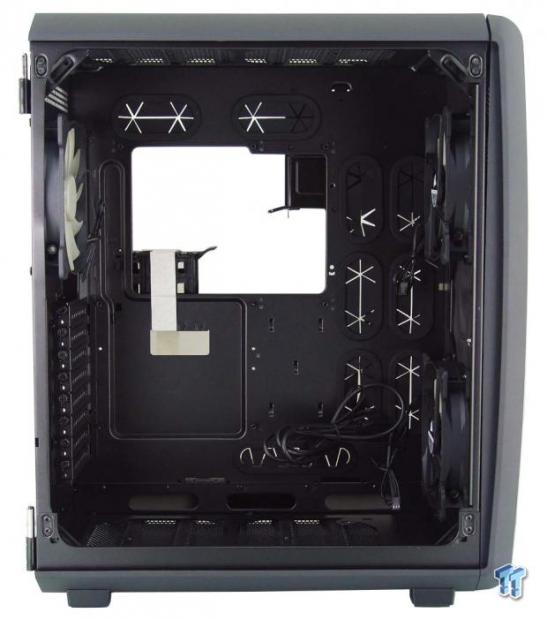
We can see a bit of tape holding the 2.5" drive rack to the motherboard tray for shipping, and the wiring is bundled together, and then run through a grommet to keep it from doing any harm to the window.
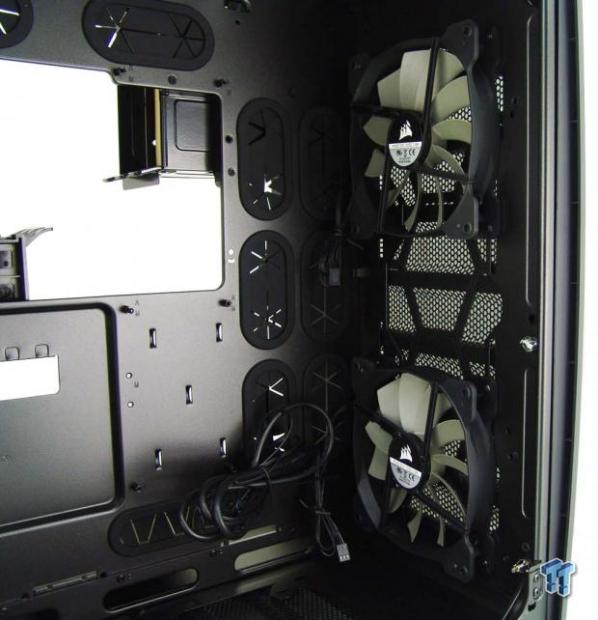
With no drive bays to block the airflow, components are kept cool by this pair of 140mm fans. They can be adjusted up and down, and wiring is easily hidden due to the proximity of the holes and grommets that run along the front edge of the motherboard tray. This area will also support up to three 120mm fans too.
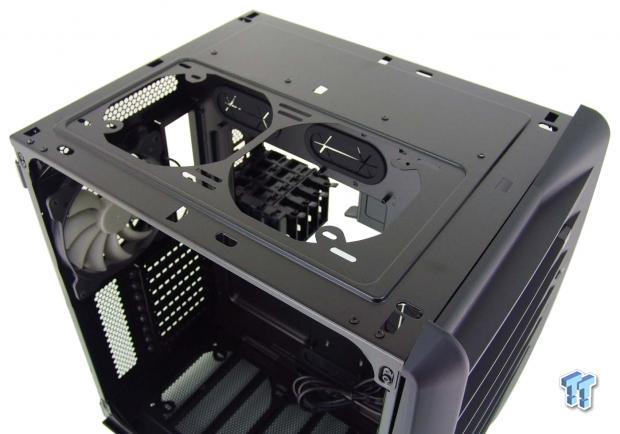
The top of the chassis offers two large round holes in which to mount fans. The mounting holes are slots, which allows for different fan spacing, as well as offering the option of 120mm and 140mm mounting holes.
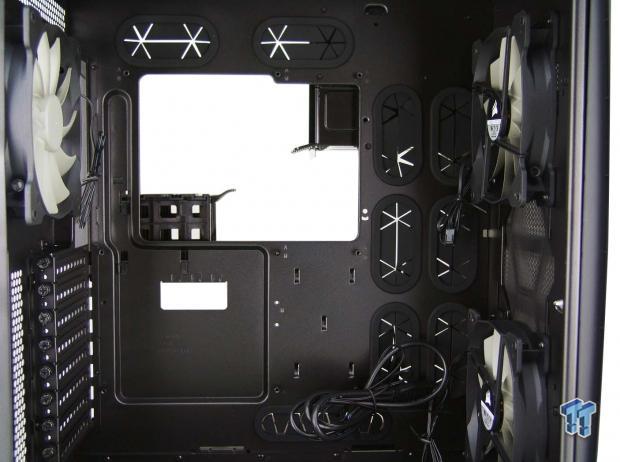
The motherboard tray takes up the entire panel in this design. With grommets above, to the right, and below, wiring can be kept clean and for the most part hidden from view. The CPU cooler access is large, the tray is clearly marked for standoffs, and tiny screws in the top right corner lock the HDD rack into the chassis.
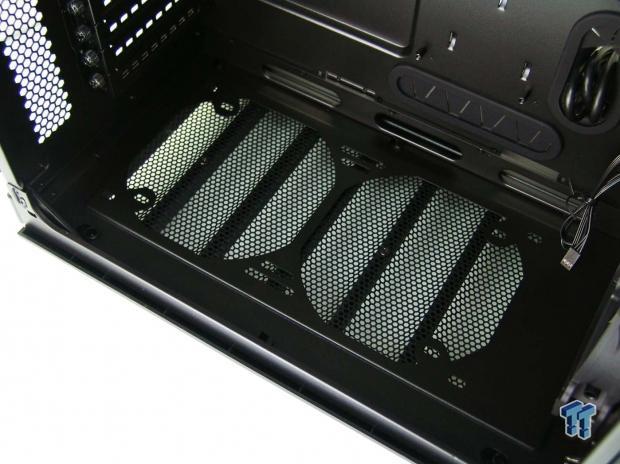
The floor of the chassis mimics the top panel, offering two large holes and the same fan installation options. With no PSU to block anything, water cooling is capable of being placed here as well.
Inside the Carbide Air 740 Continued
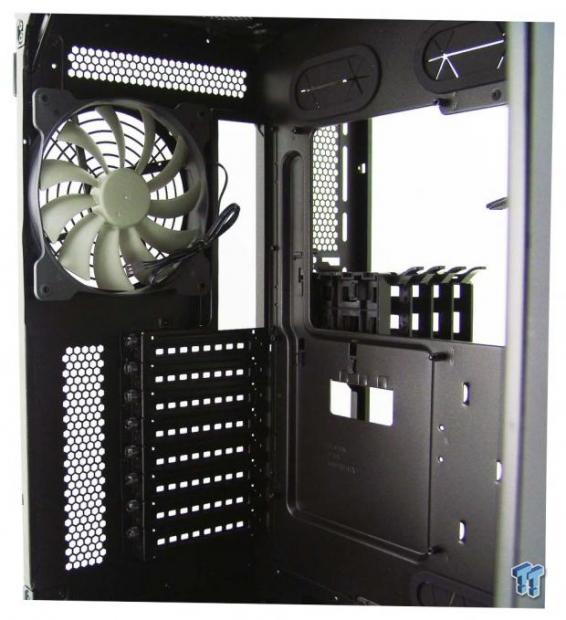
The back of the chassis is where we find the third and last fan included in the chassis, all of which are powered via 3-pin fan plugs. We can also see that the ventilated expansion slots are held in place with thumbscrews to easy mounting video cards.
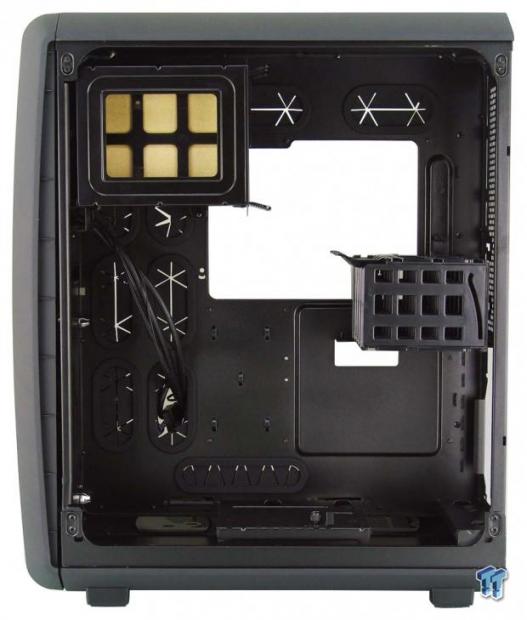
The right side chamber more closed off by components, but that is the whole idea of dual compartment designs. You can hide wiring back here, all of the drives are installed here, the PSU goes on this side, and you can even hide a pump and reservoir, and run tubing through the grommets to access the blocks.
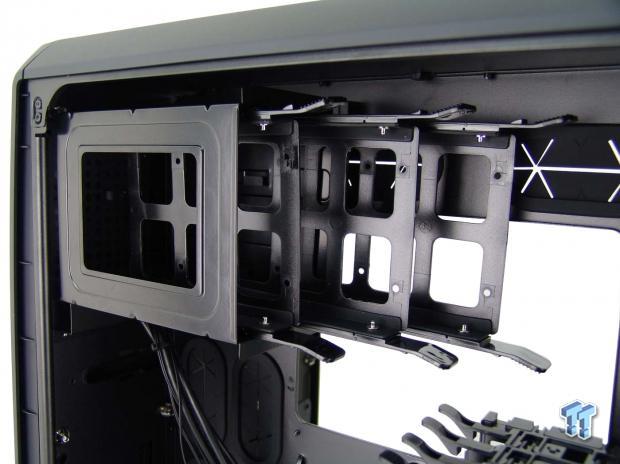
We took the hardware box out of the drive tray, but these are the three 3.5" drive bays, mounted vertically. To remove this rack for wiring or lack of use, one screw is found on the rack, and five screws through the motherboard tray hold this in place.
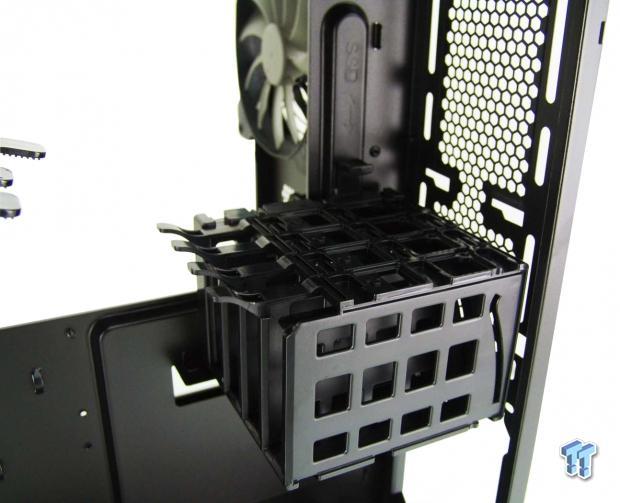
At the back, just above the PSU, we find a snap-together rack system for the 2.5" drives. You can move the tab along the back and remove all four drives. However, each tray clips on top of the next one, so you can use only what you need of the four as well.
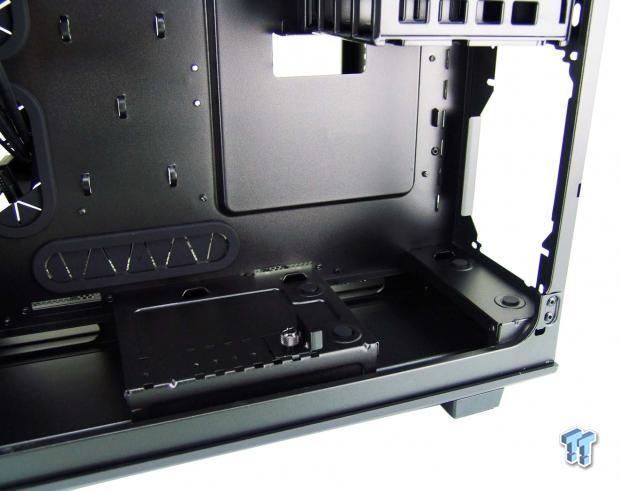
The bottom right corner of this compartment is used to install the power supply. There are four rubber pads to support the side of the PSU, allowing the fan to face out, and use the ventilation through the side panel. There is also a lock which keeps the PSU more secure, found on the front support rail.
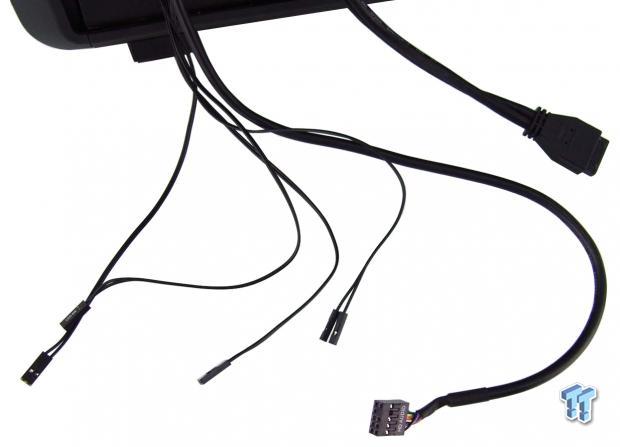
The wiring is black from stem to stern and is all contained on the right side of the chassis interior. There are wires for the power LED, power switch, reset switch, and rather than an HDD activity wire, there is a 2-pin connection marked LED switch with no place to connect it currently. The HD Audio cable is long and will reach anywhere it needs to go. The USB 3.0 cable is shorter, but is still able to reach the bottom of motherboards with ease.
Hardware & Documentation
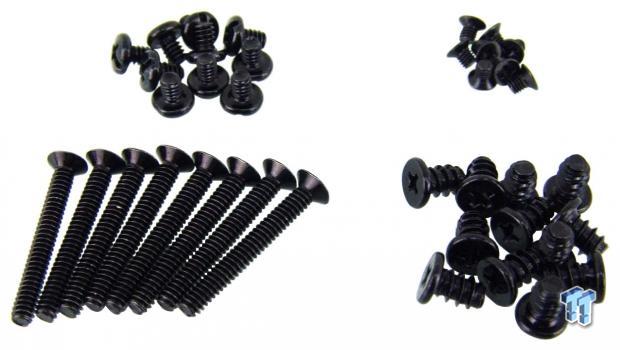
The provided screws allow you to mount the motherboard and 2.5" drives with the groups of screws at the top. Corsair also sends eight long fan screws, as well as twelve short fan screws, so that you can easily load up the optional fan locations.
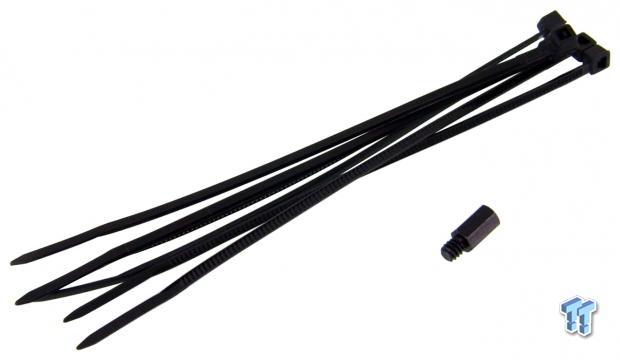
Beyond the four types of screws, this is the rest of what you are offered for hardware. There are five wire zip-ties to help aid in wire management if you are that worried about something you will never see. We are also sent an extra standoff. This is because the center one installed in the motherboard tray is a stud to help mount the motherboard, but it can be replaced with this one.
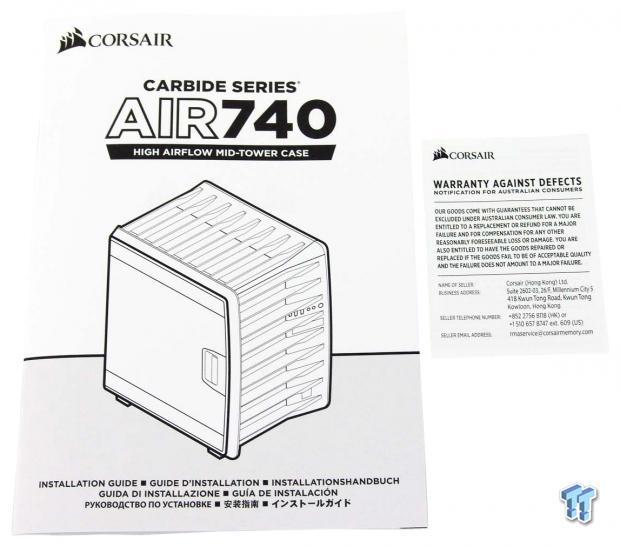
The manual is filled with a bunch of helpful information. Not only do you gain access to a parts list, and get taken on a step-by-step instruction guide to system completion, it is done well and will easy anyone into a clean looking finished product. We did notice the wiring in the manual does not match the chassis, as they list there should have been an HDD activity cable, but with no HDD activity LED present, the extra wire is connected to the back of the LED switch. The smaller insert that Corsair offers will tell you what problems are covered and if you have a chance to RMA the product because of it.
Case Build & Finished Product
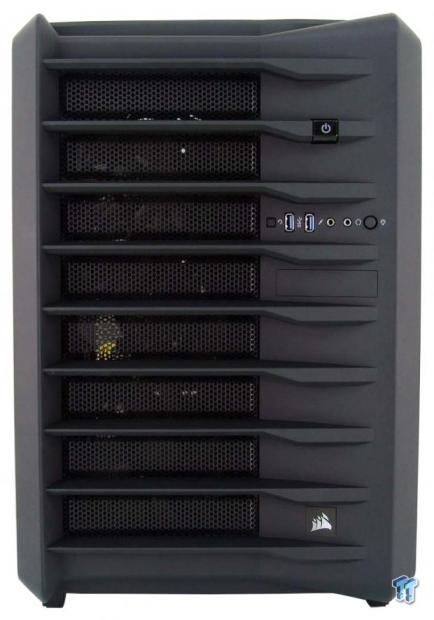
Since there is not one exposed bay to fill with components, the front of the Air 740 is just as stunning after the build as wit was when we first removed if from the box. We also like the small Corsair logo placed near the bottom, as it tells everyone who made this chassis, but does not detract from the styling, which is a huge selling point.
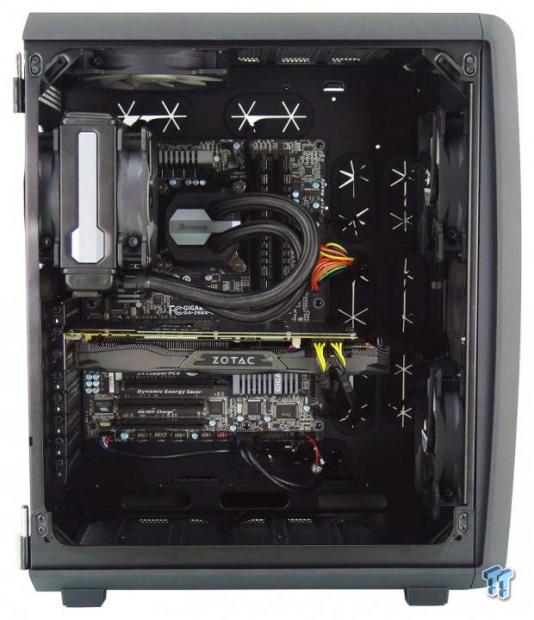
We moved the rear fan to the top to give perspective on what will fit above the motherboard. With all the room at the front and even below the motherboard, thin, thick, fans in push/pull, you have many choices when it comes to the radiator setup for water cooling.
As for the motherboard and AIO, they installed easily with so much room at hand inside of the chassis. As for the video card, we did have the flex the chassis inward, but we did get the screw holes lined up to mount it.
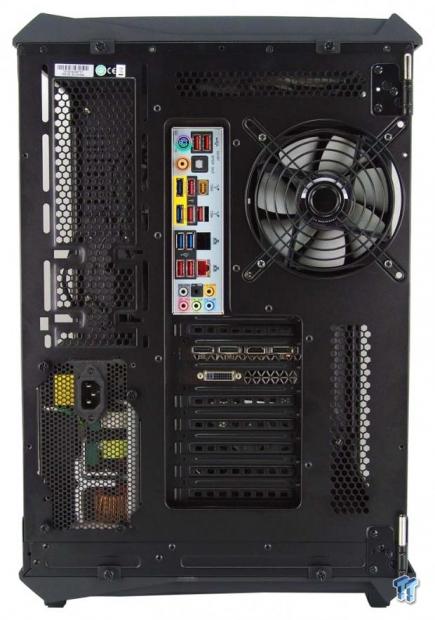
We reused the fan grill when we mounted the AIO, and even moving inward to the 120mm holes, the grill did not chatter. The dust filter snapped right in, the card rides level, and the PSU was easy to install as well but did require screws from either your bin or from the PSU manufacturer.
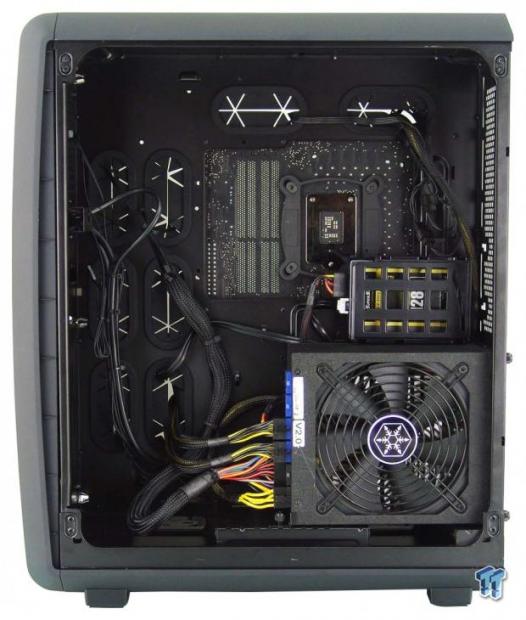
There are many grommets to run your wires through, nine in total, and as such, does not need many tie points. There may be half a dozen of the tie points, but to accomplish this, we used only two of them. We did take out the 3.5" drive rack as we do not use it, and we also removed three of the 2.5" drive trays from the SSD rack.
To be blunt, this build went so smooth that we felt we forgot something major as it took no time at all to get to completion.
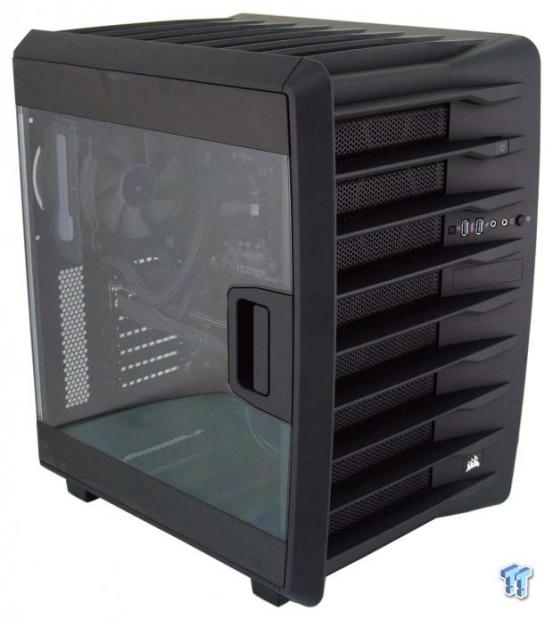
Upon first glance, the side window seemed tinted in the earlier images, but in fact, it is quite clear and shows off all of your hardware. The panels went back on the chassis without any complaints, and all we have left to do is to add some power.
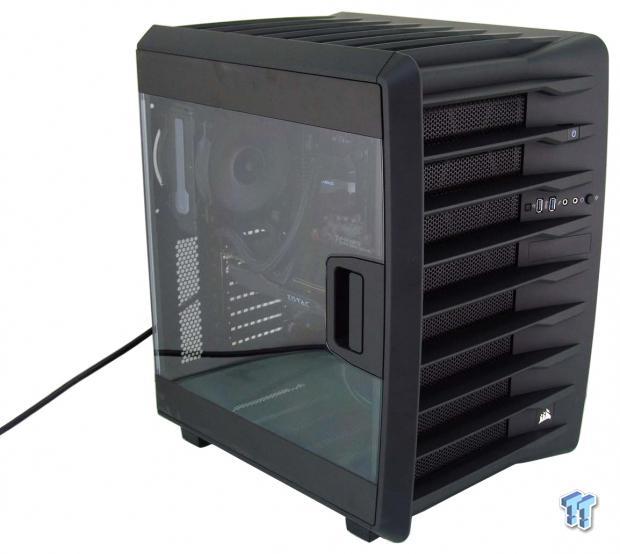
Once powered, we noticed a couple of things right away. First of all, the only LED on the outside is found in the power switch, and it glows white and is not too intense. The second thing we noted was the fact that with the fans spinning with 12V of power to them, we could only hear 33 dB of noise coming from inside the chassis. During testing, where we found our components to stay nice and cool, our AIO was by far the loudest thing inside of the Air 740.
Final Thoughts
Let's get the bad out of the way right away. The only thing we saw on this sample we did not like is that the paint along the side panels top and bottom edges was rubbed on, and appeared different under our lights. We also noticed the slight damage to the right side panel, but it had to be done before packaging. Even so, we are being very picky by mentioning this, as pre-release samples are rushed products so that we can bring them forth on release day.
We are certain these sort of issues will not rear their head in retail products. Outside of these minor cosmetic issues, we cannot get over just how great the Air 740 looks. This will be the main selling feature, as this is an aesthetic that will succeed with the masses. You will not find another chassis which looks like this, and you will also be hard pressed to find one that looks better. While we were fans of the original designs, this refresh and the way they addressed the outside with chunky lines, gentle curves, and of course that left side door, is the delicious cherry on top.
Physically, the chassis is solid, and we like the attention to the bay designs too. The way the SSD trays lock into each other is new, and something we think a lot will like as well. We like that the HDD rack was so solidly mounted to reduce the transmissions of vibrations, and allowing it to be removed opens up more possibilities. With it out of the way, it allows more access to hide tubing and other bulk water cooling components in that area instead. Also, with everything being removable, it made wiring everything much simpler. While the dual chamber design makes for a wider chassis overall, there is nothing about this design that you will dislike.
It offers free flow of air through the main chamber, keeping all of your components cooler, and on full display without any interruptions. Having the drives and PSU in the back gets everything out of view from the left side, and their placement keeps wiring runs short and sweet. We also did not notice that any of the plastic panels vibrated. This was an issue with the Air 240 chassis and is something that Corsair seems to have fixed in this design. The top, front, or bottom panels never made a peep.
You will have to dig a little deeper into your pocket for this mid-tower over many others we have seen before, but as we mentioned earlier, this is not your standard mid-tower chassis. $149 is at the upper end of pricing for this segment, but you do get everything you could want in this chassis. Room for multiple water loops, the ability to keep any build clean and tidy, and ample room in the back for all the drives you could need and want. With all of your gear inside of the Air 740, it gives you the sense that you are leaving something out. With so much room at your disposal, the Carbide Series Air 740 High Airflow PC cube chassis is everything you would ever want and some.
This chassis has won us over, and as we see it, it may be up being one of the top selling cases Corsair has ever released. The only decision you have to make at this point is, do you want it in white, or is black fine with you.
Chad's Chassis Test System Specifications
- Motherboard: GIGABYTE GA-Z68X-UD4-B3
- CPU: Intel Core i7 2600K (buy from Amazon)
- Cooler: Corsair H80i GT (buy from Amazon)
- Memory: G.Skill Ripjaws F3-12800CL6D-4GBXH
- Video Card: ZOTAC GeForce GTX 970 AMP. Extreme Edition (buy from Amazon)
- Storage: SuperSpeed 128GB SSD
- Power Supply: SilverStone SST-ST85F-G (buy from Amazon)
- OS: Microsoft Windows 7 Ultimate 64-bit (buy from Amazon)

| Performance | 100% |
| Quality including Design and Build | 96% |
| General Features | 97% |
| Bundle and Packaging | 99% |
| Value for Money | 100% |
| Overall | 98% |
The Bottom Line: If ever the time was right to jump into the Corsair Carbide Air case lineup, now is that time! It is huge for a mid-tower, delivers a clean and respectable looking build, and has aesthetics that should please anyone. The Air 740 is destined to become a huge hit.
PRICING: You can find products similar to this one for sale below.
 United
States: Find other tech and computer products like this
over at Amazon.com
United
States: Find other tech and computer products like this
over at Amazon.com
 United
Kingdom: Find other tech and computer products like this
over at Amazon.co.uk
United
Kingdom: Find other tech and computer products like this
over at Amazon.co.uk
 Australia:
Find other tech and computer products like this over at Amazon.com.au
Australia:
Find other tech and computer products like this over at Amazon.com.au
 Canada:
Find other tech and computer products like this over at Amazon.ca
Canada:
Find other tech and computer products like this over at Amazon.ca
 Deutschland:
Finde andere Technik- und Computerprodukte wie dieses auf Amazon.de
Deutschland:
Finde andere Technik- und Computerprodukte wie dieses auf Amazon.de
What's in Chad's PC?
- CPU: Intel Core i7 13700K
- MOTHERBOARD: ASUS ROG Maximus Z690 Hero Eva
- RAM: TEAM DDR5-7200 32GB
- GPU: ASUS GeForce RTX 3090 Eva
- SSD: addlink m.2 2TB
- OS: Windows 11 Pro
- COOLER: Fractal Lumen S36
- PSU: be quiet! Dark Power Pro 1500W
- KEYBOARD: ASUS ROG Strix Scope TKL Electro Punk
- MOUSE: ASUS ROG Strix Impact Electro Punk
- MONITOR: ASUS ROG Swift OLED PG42UQ
Similar Content
Related Tags

